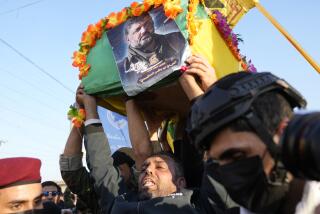It may be too late to secure Baghdad’s mix
BAGHDAD — Mohammed Rubaie, 28, is the sort of person President Bush’s new Baghdad security plan was designed to protect. But for him and his neighbors and many like them across this city, the plan comes months too late.
One of the chief rationales for sending five additional U.S. brigades to Baghdad is to secure the city’s mixed neighborhoods, U.S. military planners say. If residents feel they are safe in their homes, they will no longer turn to sectarian militias to protect them, the strategists argue.
But many of the districts that U.S. planners might have wanted to protect already have been taken over by sectarian gunmen and their allies. Formerly mixed areas, including Rubaie’s Hurriya neighborhood, have been transformed by fear and violence. Standing in their place are militantly sectarian communities, their borders hardened by concrete barriers and vigilante-run checkpoints.
Hurriya, where Rubaie was born and grew up, was one of those mixed neighborhoods -- a place in Baghdad’s northwestern corner where Sunni Arabs and Shiite Muslims lived in relative peace.
But this fall, the militias saw to it that Hurriya would no longer be mixed. One harrowing October night, “there were two gunmen dressed in black, with the police backing them up. They were saying, ‘Sunnis, you should leave now. It’s the last warning to you all. We’re going to burn your houses one by one,’ ” Rubaie said.
“When our neighbor’s house was burned, I felt it was time for us to leave,” he added.
Rubaie’s family joined a widening flood of Baghdad residents who have abandoned their home districts as the violence between Shiite militiamen and Sunni insurgents has reshaped Baghdad’s neighborhoods. In many cases, U.S. officials say, violent sectarian “cleansing” has been abetted by elements of the Iraqi security forces.
The violence has tilted the demographics of some neighborhoods from one sect to the other. In other neighborhoods, it has consolidated sectarian populations and hardened religious boundaries.
Lines are shifting
The United Nations estimates that at least 300,000 Baghdad residents have fled the country since 2003, when the capital’s population was approximately 6 million people.
In the last 11 months, since the February bombing of a Shiite shrine in Samarra triggered Iraq’s plunge into civil war, about 60,000 Baghdad residents have left their homes for other neighborhoods within the city, according to the Iraqi Ministry of Migration and Displacement.
In the last year, the lines dividing Sunnis from Shiites in Baghdad have shifted steadily to the west -- deep into what was formerly the center of the city’s Sunni population.
As recently as last summer, many people here considered the Tigris River, which snakes through the center of the capital, a rough boundary between the predominantly Sunni west bank and the largely Shiite east side. But Shiite militias, who are widely believed to have seized the advantage in Baghdad, have pushed the battle lines across the river into places such as Hurriya. By contrast, Sunni fighters have been unable to sustain advances into east Baghdad.
“They’re both taking territory from each other, but the Shiites have the upper hand in Baghdad because of Sadr’s movement,” said a U.S. advisor, referring to radical Shiite cleric Muqtada Sadr’s Al Mahdi army, a powerful militia. “They’re very aggressively taking over areas and putting Shiite families into Sunni homes,” said the advisor, who spoke on condition of anonymity because he was not authorized to discuss the matter publicly.
The militias are often backed up by sectarian elements within Iraq’s security forces. U.S. officials said they hoped that the infusion of new troops would halt sectarian sweeps, but acknowledged that in the meantime, the fighting was likely to get worse.
“Both sides are solidifying their ground right now,” the advisor said.
The list of neighborhoods that have been subjected to sectarian cleansing is long. In recent months, Sunnis have pushed Shiite families out of some neighborhoods west of the Tigris, including Yarmouk and Mansour.
Shiites have pushed Sunnis out of a longer list of neighborhoods in central Baghdad, including Babil and Riyadh. They also now dominate the Karada district, which was once heavily Christian.
Shiite militiamen have also struck deep into west Baghdad, taking over neighborhoods such as Jihad, which was recently a majority Sunni area.
U.S. advisors say the best they can hope for with Bush’s new plan is to stop future sectarian cleansing campaigns and hold Baghdad’s skewed demographics as they are, leaving restoration of abandoned, plundered and commandeered homes and neighborhoods for another day.
The balkanization of Baghdad’s neighborhoods also raises the specter of future clashes if residents who have been cast out decide to return and retake their domiciles.
A domino effect
The Sunni exodus from Hurriya illustrates the dynamics of sectarian cleansing. When Shiite fighters pushed out the Sunni residents, the residents fled south into the nearby community of Adil, where Sunnis already were in the majority, and drove out that neighborhood’s Shiites.
“The displaced from Hurriya tried to create problems and displace Shiites in Adil,” said Adnan Dulaimi, a Sunni Arab member of parliament. When Dulaimi played host to peace negotiations with local Shiites at a mosque, five mortar rounds struck the building and derailed the talks.
Sheik Mahmoud abu Abdullah, a spokesman for the Muslim Scholars Assn., a hard-line Sunni clerical group, said the Shiites have been so successful in their assaults because they constitute the majority in Baghdad and have the backing of Iraqi security forces.
“First the militias raid a Sunni area, conduct assassinations, kidnappings,” he said. “Then when the people resist, they distribute threatening pamphlets in the area. If pamphlets don’t work, the Iraqi security forces come in.”
Baghdad City Councilman Siyyid Yacoub Bukhati said commandos in one predominantly Shiite neighborhood in west Baghdad removed checkpoints recently to allow sectarian fighters into the district.
“A few days ago, six to seven cars full of gunmen came in and started shooting and told six houses of Sunnis to leave the area,” Bukhati said. “The main reason this happens is because the security forces are weak and unwilling to apply the law.”
U.S. military officials have also complained that Iraqi security forces at times appear to be assisting sectarian militias. In a recent news briefing, Army Lt. Gen. Raymond T. Odierno, the day-to-day commander for operations in Iraq, said that an earlier Baghdad security plan called Operation Together Forward failed because sectarian elements within Iraq’s security forces allowed abuses to occur.
The perceived complicity of Iraqi police and soldiers poses yet another problem for Bush’s plan because the U.S. strategy calls for Iraqi security forces to supply 20,000 troops to assist in protecting Baghdad neighborhoods.
Many here say they have little faith in those forces.
“In our neighborhood, the militias try to kidnap Sunnis from their houses,” said Abu Abdullah Maslawi, a resident of the Mansour neighborhood. “If the militias fail, the police come and arrest the people who fired at the militias. Now families are even resisting the police, because they believe they are the same as the militias.”
Times staff writers Louise Roug, Salar Jaff and Mohammed Rasheed and special correspondents in Baghdad contributed to this report.
More to Read
Sign up for Essential California
The most important California stories and recommendations in your inbox every morning.
You may occasionally receive promotional content from the Los Angeles Times.










